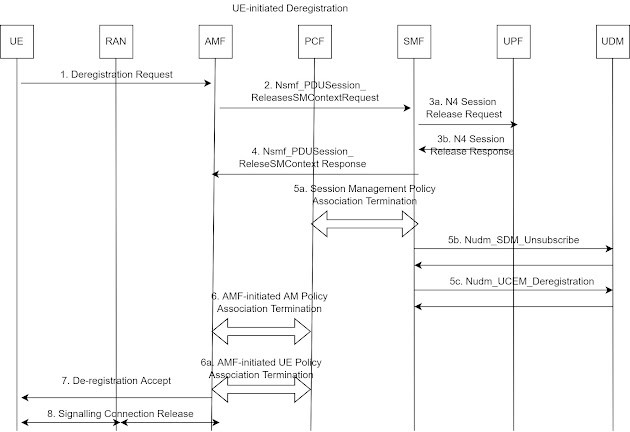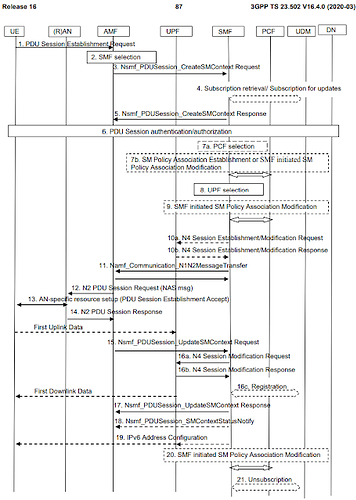5G Call Flow : Deregistration Procedure and PDU Session Establishment Procedure .
Note: Images are copyrighted material , we use here for fair use only and no copyright infringement intended.
As in we have already discussed Registration procedure . Now we will discuss Deregistration Procedure and PDU Session Establishment .
So, First Start with Deregistration.
We know that if UE(User Equipment) wants to use services of 5G then it have to first register it with the network through the registration procedure . But there is a time when UE don’t want to take services, and wants to deregister from the network so it have to sends the request for deregistration or if a network want to kick out particular UE then, this procedure is also used in this case .

Image Source - ProDeveloperTutorial.com
-
As you can see in the above image that UE sends the deregistration request to AMF through RAN.Now AMF sends the request to the SMF for releasing any User related context or any PDU Session associated with this UE.
-
SMF sends the request to the UPF for releasing any ongoing PDU session associated with this UE and tells the PCF that it no longer want PCC rules regarding this UE and PDU Session.
-
SMF also tells the UDM that , it don’t want any subscriber update and also deregister itself from the UDM as it no longer serve the session as PDU session and UE context have already released.
-
Now AMF tells the PCF it no longer required any rules related to device management , associated with this UE .
-
Once all above done , then AMF sends the message to the UE that your request to deregistration have been accepted. AMF also sends request to RAN to now release any user-related context for fully release of user related context.
So Deregistration Procedure is done through above steps . So now let’s talk about PDU Session establishment .
Image Source - Derek Cheung — Medium
-
When UE request any services from the network and sends the request for that service to AMF through RAN , then AMF see what type of service UE wants , and according to the service , it select the SMF for serving that service. For example , if UE request for IMS, then AMF select appropriate SMF for serving this service , or if UE request for Internet then it select corresponding SMF for serving the same.
-
Now, After selecting appropriate SMF, SMF communicate to the UPF for creating a PDU session which includes three types , IP based session , Ethernet based , and unstructured Session. SMF also wants PCC rules from the PCF related to the PDU session and UE. SMF also takes subscriber details and update from the UDM for authentication and authorization purpose.
-
Now UPF create tunnel and send the tunnel endpoints to SMF . SMF with this information and positive acknowledgement of creation of tunnel sends it to the AMF.AMF sends it to the RAN , now RAN create a radio bearer tunnel and now RAN knows the UPF GTP-U tunnel endpoints which was transferred by AMF . So uplink data can now be send from the device to the network.
-
RAN sends its endpoints to the AMF, now from AMF to SMF and SMF to UPF , thus now UPF also knows the RAN endpoints and it also connect its tunnel for downlink data to be send from the network to the device.Thus uplink and downlink both data can now be send from the device to the network and vice versa.
In last PDU session has been established as its made up of radio bearer and GTP-U tunnel and their connection for making up the user-plane function for communication between the device and the network.
